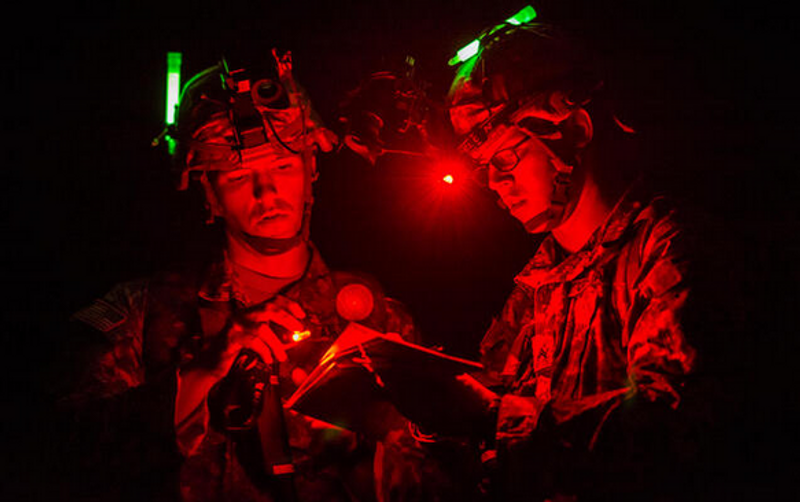Night vision is the ability to see in low-light environments, either through natural biological adaptation (scotopic vision) or with the help of night vision technology. While humans have limited night vision compared to many animals, advancements in optical technologies have made it possible to operate effectively in total darkness.
Natural Night Vision vs. Technological Enhancement
Biological Night Vision
Humans rely on specialized retinal cells called rods for low-light vision. These cells contain rhodopsin, a light-sensitive protein that helps detect dim light. However, unlike many nocturnal animals, humans lack a tapetum lucidum, a reflective layer behind the retina that enhances light capture. Animals like cats, dogs, and foxes use this adaptation for superior night vision, giving their eyes a characteristic glow in the dark.
Adaptation to darkness involves two main processes:
- Dark adaptation: Human eyes gradually adjust to low light, with full adaptation taking up to 45 minutes.
- Pupillary dilation: The pupil expands (up to 8–9 mm in some individuals) to allow more light to enter, enhancing visibility in the dark.
Spectral and Intensity Ranges
- Spectral Range: Human eyes only detect visible light. Night vision technologies expand this by capturing infrared (IR) or ultraviolet (UV) wavelengths invisible to us.
- Intensity Range: Natural night vision is limited in very low-light conditions. Technologies use sensors and image intensifiers to amplify minimal light sources like starlight.
Night Vision Technologies
Modern night vision devices fall into three main categories:
1. Image Intensification
Image intensifiers collect and amplify ambient light (like moonlight or starlight) using a vacuum tube. These devices are often used in military operations and law enforcement. Common systems include:
- Night vision goggles (NVGs)
- Low-light cameras
- ANVIS modules (popular in aviation)
Contrary to popular belief, light is not "amplified" in a literal sense. Instead, incoming photons strike a photocathode, releasing electrons that are multiplied across a microchannel plate and converted back into visible light on a phosphor screen.
2. Digital Night Vision
Digital night vision uses high-sensitivity CMOS or sCMOS sensors to digitally capture and display images in low-light conditions. These systems can function with or without infrared illumination and are found in:
- Consumer-grade night vision scopes and goggles
- Security camera systems
- Astronomical and microscopic imaging setups
Digital systems offer real-time viewing and recording capabilities, with increasing performance rivaling traditional analog systems.
3. Active Illumination
- This method combines image intensification with an infrared light source to illuminate the scene. Although invisible to the human eye, this illumination is picked up by IR-sensitive cameras, producing high-resolution grayscale imagery.
- Applications: Surveillance, tactical operations, and vehicle navigation
- Drawback: Active IR can be detected by opposing night vision equipment
- Laser range-gated imaging is a specialized technique within active illumination, using pulsed lasers synchronized with a sensor to isolate specific target ranges. It allows for detailed imaging and target identification.
4. Thermal Imaging
- Thermal vision, also known as FLIR (Forward-Looking Infrared), detects infrared radiation emitted by objects based on their heat. Unlike image intensifiers, thermal cameras:
- Require no ambient light
- Work in total darkness
- See through obscurants like smoke, fog, and light rain
- Thermal imaging is commonly used in military and aviation contexts, as well as in search and rescue and fire detection. However, it cannot see through solid walls or glass, contrary to popular myth.
Night Vision in Practice
- Night vision technology is used across numerous domains:
- Military & Tactical: For navigation, surveillance, and combat in darkness.
- Law Enforcement: For suspect tracking and perimeter security.
- Search and Rescue: To locate individuals in low-light disaster scenarios.
- Security & Surveillance: In commercial, residential, and government settings.
- Wildlife Observation & Hunting: Tracking animals without visible light.
- Conclusion
- Night vision, whether biological or technological, plays a vital role in overcoming darkness. While humans have natural limitations, innovations in image intensification, digital sensors, active IR illumination, and thermal imaging have drastically expanded our ability to see and operate in the dark.

